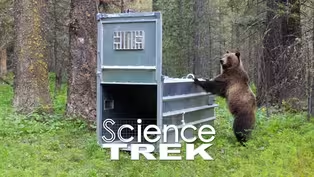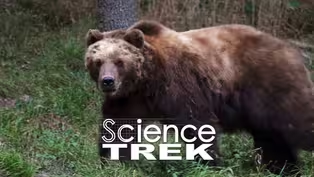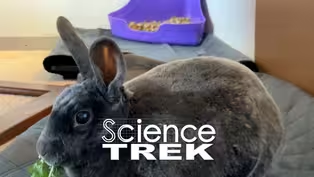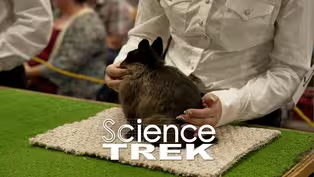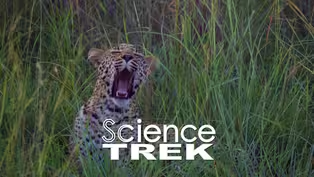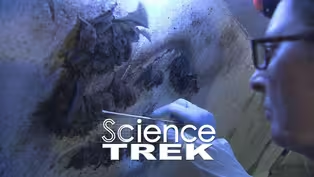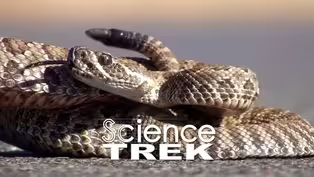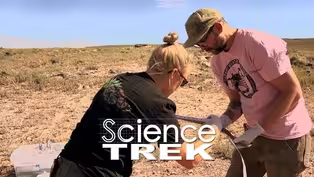
Birds of Prey: Built to Hunt
Special | 6m 52sVideo has Closed Captions
What special skills do birds of prey have that make them such good hunters?
Birds of prey include eagles, hawks, falcons, owls, and vultures. These amazing birds have specialized adaptation to make them nature’s greatest hunters and a key part of their ecosystems. Learn why these animals are sometimes called “Sky Hunters.”
Problems playing video? | Closed Captioning Feedback
Problems playing video? | Closed Captioning Feedback
Science Trek is a local public television program presented by IdahoPTV
Major Funding by the Laura Moore Cunningham Foundation and the Idaho National Laboratory. Additional Funding by the Friends of Idaho Public Television and the Corporation for Public Broadcasting.

Birds of Prey: Built to Hunt
Special | 6m 52sVideo has Closed Captions
Birds of prey include eagles, hawks, falcons, owls, and vultures. These amazing birds have specialized adaptation to make them nature’s greatest hunters and a key part of their ecosystems. Learn why these animals are sometimes called “Sky Hunters.”
Problems playing video? | Closed Captioning Feedback
How to Watch Science Trek
Science Trek is available to stream on pbs.org and the free PBS App, available on iPhone, Apple TV, Android TV, Android smartphones, Amazon Fire TV, Amazon Fire Tablet, Roku, Samsung Smart TV, and Vizio.

Science Trek
Science Trek is a place where parents, kids, and educators can watch short, educational videos on a variety of science topics. Every Monday Science Trek releases a new video that introduces children to math, science, technology, engineering, and math (STEM) career potentials in a fun, informative way.More from This Collection
Video has Closed Captions
Learn what bears like to eat and why you should avoid them. (6m 49s)
Bears: Grizzly, the Bear in a Coat
Video has Closed Captions
How are grizzly bears different from other bears? (5m 33s)
Video has Closed Captions
Architects borrow from nature all the time. Find out how. (6m 26s)
Rabbits: Are You Rabbit Ready?
Video has Closed Captions
What do you need to know before getting a rabbit for a pet. (5m 57s)
Video has Closed Captions
Showing rabbits at your local fair opens the door to science. (6m 30s)
Video has Closed Captions
What is White Nose Syndrome and why is it so deadly? (5m 15s)
Video has Closed Captions
How do bats find their food at night? (4m 17s)
Video has Closed Captions
Why do snakes always look like they are staring? (3m 43s)
Snakes: Snake Hunters for Science
Video has Closed Captions
How do you catch a rattlesnake? Very carefully. Watch! (7m 16s)
Fish: Idaho Fish Rule! Hopefully.
Video has Closed Captions
Learn about native Idaho fish and why non-native fish can be a problem. (5m 52s)
Providing Support for PBS.org
Learn Moreabout PBS online sponsorshipJOAN CARTAN-HANSEN, HOST: Birds of prey are an apex predator.
That means these amazing birds have specialized adaptations to play a crucial role in their ecosystems.
Let's find out more about birds of prey.
[MUSIC] STEPHANIE ASHLEY, CURATOR, WORLD CENTER FOR BIRDS OF PREY: So, you guys know who birds of prey are, right?
Birds of prey are Eagles and Hawks and Falcons and Owls, and then there's birds of prey that you guys probably have never heard of before, like a Seriema or a Secretary bird.
Believe it or not, there is a one called a Kite and Harriers, Ospreys are birds of prey.
And so, all of these birds, we put them together, they're in this big group of birds that we call birds of prey.
CARTAN-HANSEN: In the world of birds, raptors, or birds of prey, are king.
They have a sharp, curved beak.
They fly at amazing speed and raptors kill with their feet.
Raptors have sharp, curved talons or claws on their feet.
They can capture and hold prey.
They can snatch a fish right out of water or strike a bird in the air.
Their special beak and talons work kind of like a knife and fork, spearing and tearing food.
STUDENT: What do they eat?
CARTAN-HANSEN: Different raptors eat different things.
Some eat insects.
Others eat small mammals like chipmunks or rabbits, or sometimes fish.
Birds of prey can fly very fast and almost silently a Peregrine Falcon can dive at over 200 miles an hour.
Birds of prey have keen hearing.
A great gray owl can hear a vole running 60 feet away, even if the vol is under 18 inches of snow, and birds of prey have extremely good eyesight, a falcon can see a grasshopper 300 feet away.
That's three to eight times better than humans see.
STUDENT: Where do birds of prey live?
CARTAN-HANSEN: You can find birds of prey anywhere in the world except Antarctica.
One of the best places to find raptors is at the Morley Nelson Snake River, birds of Prey, national Conservation Area near Boise.
The canyon walls here are perfect for raptors nests.
But raptors can live anywhere there is a food supply, even in big cities.
STUDENT: When do birds of prey hunt?
ASHLEY: We have some that are really well adapted to hunting at nighttime, and those are mostly our owls.
We call that nocturnal when a bird is mostly active at nighttime.
Now, some of our owls are active at dawn and dusk mostly and not super in the middle of the night.
And so that we call corpuscular, and those birds are most active then.
And then you've got birds like eagles and hawks and falcons that are mostly active during the day, and we call that diurnal.
And so different birds of prey have different adaptations to help them with their hunting style.
STUDENT: What scientists study birds of prey?
ASHLEY: Scientists who study birds are called ornithologists.
Ornithology is a specialty because birds are different.
They have feathers, they have eyes just like we do.
They have four limbs just like we do.
They even have a four chambered heart just like we do.
But their behavior is often different.
Their brains are different from our brains.
They use them a little bit differently.
And so having birds as a specialty is important.
The habitats they live in, the way that they behave, the way they reproduce and what they need tends to be a little bit different than what mammals need.
CARTAN-HANSEN: You know, humans have always had a special relationship with birds of prey.
Jim Willmark is a licensed falconer at the World Center for birds of prey.
JIM WILLMARK, FALCONER: Falconry is the hunting of wild quarry with trained raptors.
This is a kestrel, and he is the smallest falcon in North America.
Not necessarily him himself, but the species.
This equipment on him, these anklets, and these are jesses, one on each leg, and these come down, and they're attached to a swivel and that goes on a leash.
And this is over thousands of years people have found that this is the best way to keep falcons unless they're free lofted.
So, this that I'm going to swing is a lure.
And this one looks a little like a blackbird, but it could look like anything.
And falcons are trained to a lure because often they're so far away from you that they can't hear you, but they can always see you swinging a lure.
So, if I swing this and drop it on the ground, they should come over and get it.
[KESTREL KEEING] WILLMARK: There he goes.
If you really want to be a Falconer and fly a bird, you better plan on spending a large part of your life doing it.
Most of the people that I know that are falconers end up being biologists or working with birds.
CARTAN-HANSEN: You'll find birds of prey in more places than the sky.
ASHLEY: How many sports teams can you name that use some kind of bird or bird of prey in their mascots to emulate because we think they're so cool.
And then art, how many artists have been inspired by birds of prey?
Look at all the poetry that's out there, all the photography, all the paintings, all the literature.
CARTAN-HANSEN: As important as they are to the environment and culturally, birds of prey are in trouble.
Raptors can't survive when their habitat is destroyed by fire or by humans, or if its food supply disappears or is contaminated by chemicals in the environment.
Scientists around the world are working to save those birds of prey that are threatened with extinction.
ASHLEY: The biggest reason for Raptor declines all over the world is habitat loss.
And that could be anything from plowing a really good habitat to put up a shopping mall, right?
That's the thing that people think about when they think of habitat loss, but it's also making a new road or degradation.
When we use habitat for our own purposes and we don't pick up our own trash, or we make new trails, we introduce invasive species, logging rainforest too much.
All of these things contribute to habitat loss.
CARTAN-HANSEN: So, we need to protect birds of prey.
Their status and population numbers indicate the health of their environment.
And a healthy environment is important to us all.
If you want to learn more about Birds of Prey, check out the Science Trek website.
You'll find it at ScienceTrek.org.
[MUSIC] ANNOUNCER: Presentation of Science Trek on Idaho Public Television is made possible through the generous support of the Laura Moore Cunningham Foundation, committed to fulfilling the Moore and Bettis family legacy of building the great state of Idaho, by the Idaho National Laboratory, mentoring talent and finding solutions for energy and security challenges, by the Friends of Idaho Public Television, and by the Corporation for Public Broadcasting.

- Science and Nature

Explore scientific discoveries on television's most acclaimed science documentary series.

- Science and Nature

Capturing the splendor of the natural world, from the African plains to the Antarctic ice.












Support for PBS provided by:
Science Trek is a local public television program presented by IdahoPTV
Major Funding by the Laura Moore Cunningham Foundation and the Idaho National Laboratory. Additional Funding by the Friends of Idaho Public Television and the Corporation for Public Broadcasting.
